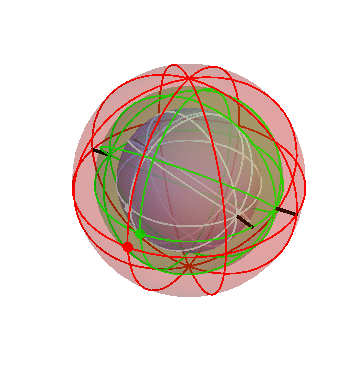Who knew that, a dozen years after I wrote something trying to explain a bit about black holes, people would still be reading it? I get questions from time to time from readers, and I’m happy to try to answer them. As long as I’m writing answers anyway, I’ll go ahead and post them here in case anyone else is interested.
This batch is from a high school student named Brandon Thrush.
1. I have a good idea of what the event horizon is, but I do not know what you mean when you say that it is actually moving outward at the speed of light; does this mean that the whole entire black hole is moving at the
speed of light?
This is a very subtle and potentially confusing idea.
Suppose that you dropped a flashlight into the black hole, and at the exact moment it crossed the horizon, it emitted a photon (that is, a little burst of light) in a direction straight out, away from the black hole. That photon would be stuck on the horizon, never falling into the black hole but never getting further away either. Now, one of the main ideas of relativity is that light always travels at the same speed (the speed of light, naturally!) no matter how it’s measured or by whom. So that photon is, by definition, traveling at the speed of light, and yet
it’s staying right on the horizon. The logical conclusion is that the horizon is moving at the speed of light.
You might say that this is just a silly word game: Why do I say the horizon is moving outwards, rather than saying that the photon is sitting still? The answer is just that the idea that the speed of light is always
the same (which means that photons never sit still) is so powerful and useful that physicists hate to give it up. We’d rather say that the horizon is moving at the speed of light — even though it never gets anywhere! — than give up on that idea.
At this point, it’s customary to mention the quote from Lewis Carroll’s Through the Looking Glass, in which the Red Queen says something like “Here it takes all the running you can do just to stay in the same place.
If you want to get anywhere, you’ll have to go a great deal faster than that!”
2. When you give examples of two black holes, one smaller than the other, you say that in the smaller black hole you would be torn apart before you even reach the horizon, but in the larger one, you would not be torn apart until after you reach the horizon. How can this be?
The reason is that the thing that tears you up is the “tidal force,” which has to do with the difference in the strength of the gravitational pull between one end of you and the other end. If every atom in your body is
being pulled on (and hence accelerated) by gravity in the same way, you won’t feel any ill effects, but if one part of you is being pulled more strongly than the other, you will. For a large black hole, the scale of everything is so big that there’s no real difference between the pull on your head and the pull on your feet: both are huge, but they’re essentially the same. For a smaller black hole, each of those pulls is smaller, but they’re different, and that’s what matters.
3. When a black hole is formed, it is because of a dying star, but does the star suddenly collapse under its own gravitational force and what is left is its gravitational force field, called the black hole, or does the star gradually collapse into its own force field?
I think I like the first way of saying it better. Certainly “suddenly” is better than “gradually”: although the leadup to the final collapse is gradual, once the final collapse gets started, it’s very quick.
There’s another obligatory literary reference here, by the way: “Gradually and then suddenly” is the way Hemingway describes going bankrupt in The Sun Also Rises.
The big idea is that, before it collapses, a star exists in an equilibrium, in which the pressure caused by the star’s particles (nuclei and electrons) balances the pull of gravity. When a black hole forms, the reason is that that balance couldn’t be sustained, and gravity won. The particles get pulled in closer and closer to the center. After that process is complete, all that an outside observer can detect is the gravitational field (which we often prefer to call the “curvature of spacetime.”)
4. When the star is collapsing into the center, what happens to the particles while reaching the center? What is their fate?
Once they get very near the center, we have to admit that we just don’t know. Everything we say about what happens to particles inside the horizon of a black hole is based on theory, not observation, since we never see the interior. But at first (that is, immediately after crossing the horizon) we can have pretty high confidence in our descriptions of the process: the physical conditions at first are very similar to situations we see in other places, so we think we understand them. But near the center, the densities and temperatures get very high, eventually passing out of the range where we think we understand the physics.
So here’s what we can say: during the collapse, the particles that are falling in towards the center get compressed to higher and higher densities and higher and higher temperatures until, at some point, …. we don’t really know.
5. When a large black hole, such as a stellar-mass black hole, constantly grows, does the gravitational field extend farther and farther? If so, would not the black hole eventually consume everything in the universe?
The first rule to remember is that a black hole of a certain mass has just the same gravitational pull as any other object of that mass. So, for instance, a black hole the mass of the Sun attracts outside objects just as much as the Sun does, and no more.
Now, it’s true that as a black hole sucks in more stuff, its mass grows, and so does its gravitational pull. But after the black hole has gotten all of the stuff near to it, it stops adding new matter at any significant rate, and so it stays pretty much the same after that.
In principle, every black hole in the universe is slowly adding more mass and hence pulling more strongly, but it’s important to emphasize the word “slowly.” A typical black hole, after it’s had some time to clean out its immediate surroundings, grows at such a slow rate that even over the lifetime of the Universe we wouldn’t expect its mass to grow very much.
6. You refer to a large black hole as a “stellar-mass” black hole, but what are the different names given to the different sizes of black holes? What are they from the smallest to the largest?
I have to admit that I’m not up-to-date on the subject of classification of black holes. The last time I paid much attention to the subject, two main categories of black holes were thought to exist:
- Black holes that formed from the collapse of stars. These typically have masses of about 10 times the mass of the Sun (plus or minus quite a bit).
- Black holes at the centers of galaxies. A typical mass for these is a million times the mass of the Sun. The conventional wisdom seems to be that most large galaxies have one of these, and that they formed along with the galaxy itself.
When I talk about stellar-mass black holes, I mean the first category. The other kind are most often called supermassive black holes.
It’s perfectly possible for black holes to exist with other masses. People have talked seriously about the possibility of microscopic black holes, for instance. But the black hole candidates that people have found in the
sky mostly fall into those two categories. (I think that some black hole candidates have been found with masses in between the two categories — say around a thousand times the mass of the Sun — but I don’t know much
about that.)


